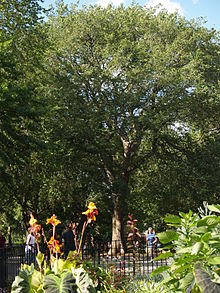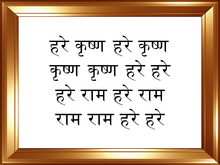- Hare Krishna (mantra)
-
The Hare Krishna mantra, also referred to reverentially as the Maha Mantra ("Great Mantra"), is a sixteen-word Vaishnava mantra which first appeared in the Kali-Santarana Upanishad, and which from the 15th century rose to importance in the Bhakti movement following the teachings of Chaitanya Mahaprabhu.
According to Gaudiya Vaishnava theology, one's original consciousness and goal of life is pure love of God (Krishna).[1] Since the 1960s, the mantra has been made well known outside of India by A. C. Bhaktivedanta Swami Prabhupada and his International Society for Krishna Consciousness (commonly known as "the Hare Krishnas").[2]
Contents
Mantra
 Mahamantra in simple english
Mahamantra in simple english
The Hare Krishna mantra is composed of Sanskrit names in the vocative case: Hare, Krishna, and Rama (in Anglicized spelling, the transliteration of the three vocatives is hare, kṛṣṇa and rāma, pronounced [ˈhɐreː, ˈkr̩ʂɳɐ, ˈraːmɐ]). It is an anustubh poetry stanza:
Hare Krishna Hare KrishnaKrishna Krishna Hare Hare
Hare Rama Hare Rama
Rama Rama Hare Hare"Hare" can be interpreted as either the vocative of Hari, another name of Vishnu meaning "he who removes illusion", or as the vocative of Harā,[3] a name of Rādhā,[4] Krishna's eternal consort or Shakti. According to A. C. Bhaktivedanta Swami Prabhupada, Harā refers to "the energy of God" while Krishna and Rama refer to God himself, meaning "He who is All-Attractive" and "He who is the Source of All Pleasure".[5] Rama can refer to Ramachandra or to Krishna as Radha-Raman, another name of Krishna meaning beloved of Radha.[6] In the hymn Vishnu Sahasranama spoken by Bhishma in praise of Krishna after the Kurukshetra War, Krishna is also called Rama.[7] Rama can also be a shortened form of Balarama, Krishna's first expansion.[8]
The mantra is repeated, either out loud (kirtan), softly to oneself (japa), or internally within the mind. A.C Bhaktivedanta Swami describes the process of chanting the Maha Mantra as follows:
Krishna consciousness is not an artificial imposition on the mind; this consciousness is the original energy of the living entity. When we hear the transcendental vibration, this consciousness is revived ...[]... This chanting of 'Hare Krishna, Hare Krishna, Krishna Krishna, Hare Hare / Hare Rama, Hare Rama, Rama Rama, Hare Hare' is directly enacted from the spiritual platform, and thus this sound vibration surpasses all lower strata of consciousness - namely sensual, mental, and intellectual ...[]... As such anyone can take part in the chanting without any previous qualification.—[9]History
 The Hare Krishna Tree in Tompkins Square Park, New York City under which Bhaktivedanta Swami Prabhupada began the first recorded public chanting of the Hare Krishna mantra outside of India.[10]
The Hare Krishna Tree in Tompkins Square Park, New York City under which Bhaktivedanta Swami Prabhupada began the first recorded public chanting of the Hare Krishna mantra outside of India.[10]
The mantra is first attested in the kalisaṇṭāraṇopaniṣad (Kali Santarana Upanishad), a Vaishnava Upanishad associated with the Krishna Yajurveda. In this Upanishad, Narada is instructed by Brahma (in the translation of K. N. Aiyar):
Narada asks to be told this name of Narayana, and Brahma replies[citation needed]:
Hare Rama Hare Rama, Rama Rama Hare Hare, Hare Krishna Hare Krishna, Krishna Krishna Hare Hare; These sixteen names are destructive of the evil effects of Kali. No better means than this is to be seen in all the Vedas.The mantra was popularized by Chaitanya Mahaprabhu roughly around 1500 AD when he began his mission to spread this mantra publicly to "every town and village" in the world, travelling throughout India, and especially within the areas of Bengal and Orissa.[11] Some versions of the Kali Santarana Upanishad give the mantra with Hare Rama preceding Hare Krishna(as quoted above), and others with Hare Krishna preceding Hare Rama. as in Navadvipa version of the manuscript. The latter format is by far the more common within the Vaishnava traditions.[12] It is a common belief that the mantra is equally potent when spoken in either order.[13]
A. C. Bhaktivedanta Swami Prabhupada, a pure devotee of Krishna in disciplic succession, on the order of his guru, Srila Bhaktisiddhanta Sarasvati Thakura, brought the teachings of Sri Chaitanya from Bharat (India) and single-handedly took the responsibility of spreading them around the Western world. Beginning in New York 1965, he encircled the globe fourteen times in the final eleven years of his life, thus making 'Hare Krishna' a well-known phrase in many parts of the world.[14]
Hippie culture
In the late 1960s and early 1970s, the Hare Krishnas became confused with the hippie subculture. This was an erroneous association, as the ideals of these groups are quite different. Although Prabhupada was open to anyone becoming a member of the Hare Krishnas, they had to follow the four regulative principles, one of which is strict abstention from intoxicants, including marijuana.[15] Elevation and joy were to be derived from chanting God's holy names.
The hippie Broadway musical "Hair" has a song, "Be-In" with the mantra in it, along with some additional lyrics.
Popular culture
Further information: Hare Krishna in popular cultureThe Hare Krishna mantra appears in a number of famous songs, notably those sung by The Beatles (in the lyrics of John Lennon and George Harrison), and has been at the number-one spot in the UK singles charts on more than one occasion within songs such as Harrison's "My Sweet Lord". George Harrison put a Hare Krishna sticker on the back of the headstock of Eric Clapton's 1964 Gibson ES-335; the sticker also appeared on Gibson's 2005 reproduction of the guitar.
The mantra also appears in The Pretenders' Boots of Chinese Plastic.[16]
The Radha Krsna Temple's recording Hare Krsna Mantra was released as a single on The Beatles' Apple Records label in 1969, and reached #12 in the UK music chart and appeared on the music show Top of the Pops. It also made the #1 slot in both German and Czechoslovakian music charts.
Less well-known but equally relevant to fans of pop music culture are recordings of the Hare Krishna mantra by The Fugs on their 1968 album Tenderness Junction (featuring poet Allen Ginsberg), by Nina Hagen, and by Hüsker Dü on their 1984 album Zen Arcade. [17]
Kula Shaker, Boy George, and members of The Rubettes have recorded music tracks about Krishna Consciousness.
At the 2008 and 2009 VMA Awards, the host, English comedian Russell Brand ended the ceremony by saying Hare Krishna, as he does at all his shows.
The Washington D.C. Production duo Thievery Corporation released a track on the 2008 album entitled, "Hare Krishna".
In the Muppet Movie a running gag entailed one character saying they were lost and the other saying "maybe you should try Hare Krishna."
In the Seinfeld episode The Subway, a patron in Monk's restaurant yells, "Hare Krishna! Hare Krishna!" when he sees George walk in wearing only a bedsheet. A similar scenario occurs in Scrubs when J.D. shaves his head in support for a chemo patient, and in the movie Stripes when John Candy's character leaves the army barber.
The Hare Krishnas are featured in the popular video game series Grand Theft Auto originally as pedestrians, and in later installments as a gang.
The band Shelter features themes and lyrics of Hare Krishna culture .
In the film 'Osmosis Jones' (2001), Jones pushes past two cells in Franks stomach who are singing 'Hare Krishna' whilst playing a drum and jiggling a tambourine.
Scriptural references
The practice of chanting the Hare Krishna mantra is recommended in the Puranas, the Pañcaratra, and throughout Vaishnava literature in general.[18] For example:
All the grievous sins are removed for one who worships Lord Sri Hari, the Lord of all lords, and chants the holy name, the Maha-mantra.
— Padma Purana, 3.50.6
When the sixteen names and thirty-two syllables of the Hare Krishna mantra are loudly vibrated, Krishna dances on one's tongue
— Stava-mala-vidyabhusana-bhasya, Baladeva Vidyabhusana in Bhaktisiddhanta's Gaudiya Kanthahara 17:30
See also
Footnotes
- ^ Caitanya Caritamrta Ml.20.340.
- ^ Religion Encyclopedia - Hare Krishna (ISKCON)
- ^ Meditations on the Hare Krishna Mahamantra "[Hare] = O Hari!...." & "Because she steals Krishna's mind and because she is the embodiment of Krishna's divine joy, Sri Radha is known as Hara. Hare is the vocative form of that name".
- ^ Rosen, S. (2006). Essential Hinduism. Praeger Publishers. ISBN 0275990060.P.4: It was preserved in the confidential sampradayas, or esoteric lineages, that were guardian to these truths from the beginning. p.244: In a more esoteric sense, the word "Hare" is a vocative form of "Hara," which refers to Mother Hara, or Sri Radha.
- ^ "The word Harā is a form of addressing the energy of the Lord, and the words Krishna and Rama (which mean "the highest pleasure eternal") are forms of addressing the Lord Himself." - A. C. Bhaktivedanta Swami Prabhupada. See Krishna.com article.
- ^ Gaudiya.com - Practice "Rama is another name for Him [Krishna], meaning the one who brings delight to Radha".
- ^ T. V. Gopal (2000). Hrishikesa: Krishna - A Natural Evolution. Parkland, Fla: Universal Publishers. p. 101. ISBN 1-58112-732-4.
- ^ Chaitanya Charitamrita Adi-5.132 "if someone says that the "Rama" in "Hare Rama" is Lord Ramacandra and someone else says that the "Rama" in "Hare Rama" is Sri Balarama, both are correct".
- ^ For the original text, see this Krishna.com article.
- ^ Hare Krishna Tree.
- ^ gaudiya.com.
- ^ Steven J. Rosen, Vaiṣṇavism: contemporary scholars discuss the Gauḍīya tradition ISBN 8120812352, p. 274.
- ^ No Water in the Desert Bombay, December 12, 1974: "Sometimes they first of all place "Hare Rama, Hare Rama, Rama Rama, Hare Hare." And sometimes they place "Hare Krsna, Hare Krsna, Krsna Krsna..." There is no difference. Sometimes they say, "No, it should be Hare Rama first." Sometimes they..., "No, Hare Krsna." But that is not very important".
- ^ Biography of Srila Prabhupada.
- ^ Hare Krishnas and ISKCON "These physical pleasures, the eating of fish, meat or eggs, the use of intoxicants, illicit sex, and gambling and frivoulous sports, are called the four regulative principles. Because of the rejection of these pleasures, Krishnas practice a strict vegetarian lifestyle."
- ^ "Pretenders - Boots Of Chinese Plastic Lyrics". Metrolyrics.com. http://www.metrolyrics.com/boots-of-chinese-plastic-lyrics-pretenders.html. Retrieved 2009-11-01.
- ^ Radha Krsna Temple.
- ^ References to the Maha Mantra (pdf).
References
- Translated by K. Narayanasvami Aiyar, Copyright © 2002-2008 Celextel Enterprises Pvt. Ltd.- Vedanta Spiritual Library. "English translation of the Kali Santarana Upanishad". www.celextel.org. http://www.celextel.org/108upanishads/kalisantarana.html. Retrieved 2008-05-06.
- Klostermaier, Klaus K. (2000). Hinduism: A Short History. Oxford: Oneworld Publications. ISBN 1-85168-213-9
External links
Categories:- Hindu denominations
- Hindu mantras
- Krishna
- Meditation
- Sanskrit words and phrases
- Vaishnavism
Wikimedia Foundation. 2010.


